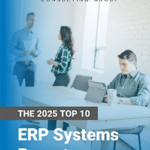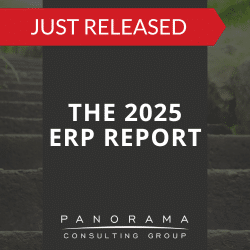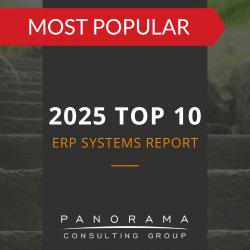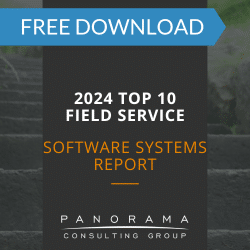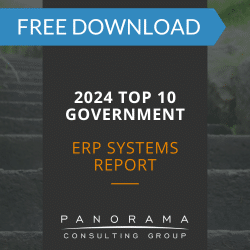- Unapproved applications create data silos that undermine ERP integration, leading to inconsistent reporting, duplicate records, and inefficiencies.
- Shadow IT introduces security vulnerabilities by bypassing enterprise security controls, increasing the risk of data breaches and compliance failures.
- Lack of IT oversight leads to undetected tools, causing integration challenges, system incompatibilities, and long-term technical debt.
- Strong IT governance and proactive change management are essential to managing Shadow IT, ensuring ERP systems meet user needs while maintaining security and compliance.
Shadow IT—the use of unauthorized software or systems within an enterprise—is a persistent challenge for organizations adopting new ERP software. Shadow IT often operates unnoticed across departments, housing critical business data and supporting essential workflows outside of IT’s control. Their presence can plague ERP systems with data silos, integration roadblocks, and security risks.
Today, we’ll explore the risks associated with unauthorized systems in enterprise environments, how Shadow IT can hinder the success of ERP projects, and actionable strategies to maintain control and oversight.
Understanding Shadow IT and Its Role in ERP Environments
Shadow IT encompasses any application, software, or technology solution implemented without the knowledge or approval of the IT department. From simple spreadsheet tools to sophisticated SaaS platforms, Shadow IT often emerges as employees seek to bypass perceived limitations in new or existing systems.
For example, an employee frustrated by slow reporting capabilities in a supply chain management system might adopt a third-party analytics tool without IT’s approval. While this may offer a short-term fix, it creates long-term risks for the organization.
Modern ERP systems rely on seamless data flow and rigorous IT governance. Shadow IT impedes this equilibrium with unauthorized entry points, fragmenting data, and operational inefficiencies.
In many of our project recovery engagements, Shadow IT was identified as a root cause of ERP failure. This is particularly true in manufacturing companies, where unauthorized systems often lead to inaccurate production planning and disrupted supply chain processes.
Contemplating litigation?
We have multiple software expert witnesses available for provision of reports, depositions, and testimonies.
The Risks of Shadow IT in ERP Projects
The pervasive presence of Shadow IT in organizations can quietly derail even the best ERP system. To fully grasp its potential for disruption, it’s essential to explore the key risks Shadow IT introduces and why addressing these issues is critical for long-term ERP success.
1. Data Fragmentation and Integrity Issues
ERP systems are designed to provide a single source of truth by consolidating data across the enterprise. Shadow IT undermines this principle with isolated data silos. These silos often lack the security and governance protocols of an authorized ERP system, leading to inconsistent or incomplete information.
For example, an employee using an unauthorized expense tracking app may inadvertently create discrepancies between the data recorded in the ERP’s financial module and actual expenses. Over time, these small inconsistencies can cascade into significant errors that compromise the reliability of the ERP system.
2. Increased Security Vulnerabilities
One of the most critical dangers of Shadow IT is its impact on enterprise security. Unauthorized applications may lack the encryption, access controls, and compliance measures required for enterprise use. This creates vulnerabilities that can lead to data breaches or ransomware attacks.
ERP projects involve migrating sensitive business data, so they are particularly vulnerable to such risks. A single unsecured Shadow IT application can serve as an entry point for cyberattacks, compromising the integrity of your entire ERP system.
3. Disruption of IT Governance
Strong IT governance ensures that technology investments align with business goals, reduces duplication of effort, and enforces compliance. Shadow IT undermines this governance structure by circumventing established policies.
Without visibility into these tools, your IT team cannot provide adequate support or ensure that they integrate effectively with the broader ERP ecosystem. This lack of coordination can lead to operational inefficiencies and increased costs.
4. Higher Likelihood of ERP Failure
In some cases, Shadow IT can result in the abandonment of ERP projects, as teams become overwhelmed by the complexity of reconciling authorized and unauthorized systems.
An independent ERP consultant can help identify and address these challenges during the selection and implementation process, but even their expertise has limits when Shadow IT remains unchecked.
Strategies to Combat Shadow IT in ERP Projects
Addressing the risks of Shadow IT requires more than identifying its presence; it demands a strategic, organization-wide response to eliminate vulnerabilities and foster alignment. By adopting proactive measures, you can create an environment where ERP systems meet employee needs, unauthorized applications are minimized, and IT governance is reinforced.
The following strategies provide a roadmap to combat Shadow IT effectively and ensure the success of your ERP project.
1. Foster a Culture of Transparency and Collaboration
The first step in combating Shadow IT is to foster a culture where employees feel empowered to voice their technology needs.
Rather than simply banning Shadow IT, organizations should seek to understand why employees rely on these tools and determine whether their needs can be met within the ERP system.
A collaborative approach to ERP implementation ensures that end-user needs are addressed. Change management consulting can play a crucial role in facilitating this cultural shift and ensuring that employees embrace the ERP system.
2. Strengthen IT Governance Frameworks
Robust IT governance is essential for preventing Shadow IT before, during, and after an ERP implementation. This includes clear policies on technology procurement, regular audits to identify unauthorized systems, and a centralized approval process for new applications.
Many organizations also benefit from independent verification and validation (IV&V) during ERP projects. This approach ensures that all systems, authorized or otherwise, align with enterprise goals and adhere to security standards.
3. Leverage Modern ERP Solutions with Built-In Flexibility
One of the root causes of Shadow IT is the rigidity of legacy ERP systems. If employees feel an ERP lacks necessary functionality, they will continue using unauthorized tools in parallel.
By selecting a modern ERP solution with built-in flexibility—such as customizable dashboards, AI-driven analytics, and seamless integration with third-party tools—you can reduce the likelihood of employees using unauthorized alternatives.
An ERP selection consultant can help you select the best ERP system for your organization’s unique needs. Whether you’re focused on supply chain software, manufacturing ERP systems, or financial applications, an independent consultant can guide you toward solutions that minimize the use of Shadow IT.
4. Implement Rigorous Security Protocols
To address the security risks of Shadow IT, implement enterprise-wide security protocols, including advanced threat detection, endpoint monitoring, and employee training programs. A proactive approach to cybersecurity ensures that unauthorized applications are identified and addressed before they compromise your ERP system.
Shadow IT as a Strategic Priority
For executives overseeing ERP projects, Shadow IT is a strategic risk that can compromise digital transformation success. By understanding the dangers of unauthorized systems and implementing proactive strategies to address them, you can ensure the integrity and effectiveness of your ERP system.
Shadow IT may be pervasive, but it doesn’t have to undermine your ERP project. Our independent ERP consultants can help you untangle the complexities of Shadow IT. Contact us below for a free ERP consultation.
